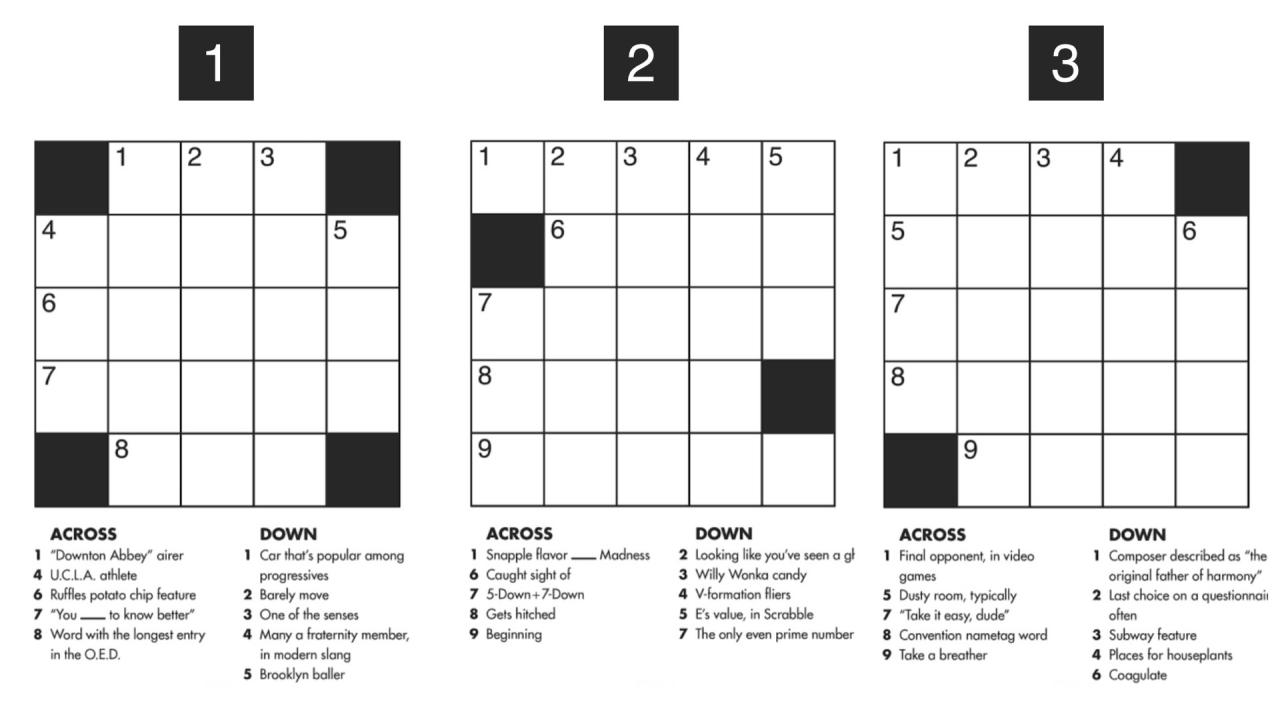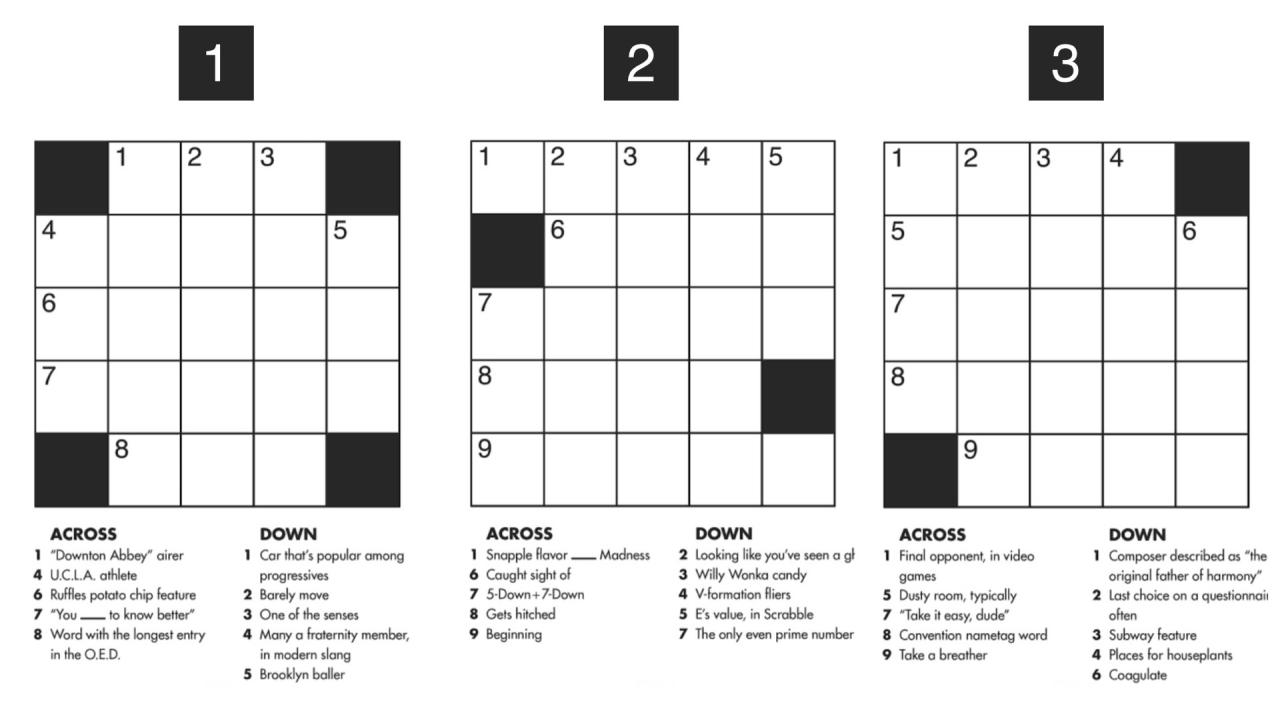Immerse yourself in the fascinating world of mini crosswords, where wordplay, strategy, and a touch of puzzle-solving magic intertwine. Discover the captivating variations, delve into the art of construction, and master the techniques to conquer these enigmatic puzzles.
From cryptic clues to themed grids, mini crosswords offer a diverse playground for word enthusiasts. Dive into the intricacies of puzzle-within-a-puzzle designs and unravel the secrets of effective solving strategies. Whether you’re a seasoned solver or a crossword novice, this comprehensive guide will elevate your mini crossword experience to new heights.
Mini Crossword Variations
Mini crosswords offer a delightful variation on the classic crossword puzzle, providing a fun and engaging challenge in a compact format. These puzzles come in various types, each with its unique characteristics and solving strategies.
Cryptic Crosswords
Cryptic crosswords are renowned for their enigmatic clues that require lateral thinking and wordplay. The clues often use puns, anagrams, homophones, and other linguistic tricks to lead solvers to the correct answers. Solving cryptic crosswords demands a keen eye for detail and a willingness to think outside the box.
Themed Crosswords
Themed crosswords revolve around a central theme, with all the clues and answers related to that theme. These puzzles can be a great way to explore specific topics or interests, such as history, geography, or pop culture. The theme often provides valuable context clues that can assist in solving the puzzle.
Puzzle-within-a-Puzzle Crosswords
Puzzle-within-a-puzzle crosswords incorporate a smaller crossword grid within the main grid. The clues for the smaller grid are often hidden within the clues for the main grid, adding an extra layer of complexity. Solving these puzzles requires careful reading and attention to detail to uncover the hidden clues.
Tips for Solving Mini Crosswords
* Read the clues carefully:Pay attention to every word and punctuation mark in the clues.
Don’t be afraid to guess
Sometimes, an educated guess can lead you to the correct answer.
Look for patterns
Many mini crosswords use patterns in their clues or answers.
Use a pencil
Mistakes are inevitable, so be prepared to erase and try again.
Take breaks
If you get stuck, step away from the puzzle for a while and come back to it later with a fresh perspective.
Mini Crossword Construction

Mini crosswords are a smaller version of the traditional crossword puzzle, typically measuring 5×5 or 7×7 squares. They are a great way to practice your crossword-solving skills or to introduce someone new to the game. Mini crosswords can be just as challenging as their larger counterparts, but they are also more accessible, making them a great option for beginners.
To create a mini crossword puzzle, you will need to start with a grid. The grid should be a square, and the number of squares will depend on the size of the puzzle you want to create. Once you have a grid, you can start to fill in the squares with letters.
The letters should form words that intersect each other, and each word should have a clue.
Grid Design
The grid is the foundation of a crossword puzzle. It determines the size and shape of the puzzle, as well as the number of words that can be included. When designing a grid, it is important to consider the following factors:
- The size of the grid: The size of the grid will determine the difficulty of the puzzle. Smaller grids are easier to solve than larger grids.
- The shape of the grid: The shape of the grid can also affect the difficulty of the puzzle. Grids with unusual shapes can be more challenging to solve than grids with regular shapes.
- The number of words: The number of words that can be included in a grid is limited by the size of the grid. Smaller grids can accommodate fewer words than larger grids.
Clue Writing
The clues are what make a crossword puzzle challenging. Good clues are clear and concise, but they also provide enough information to allow the solver to figure out the answer. When writing clues, it is important to consider the following factors:
- The length of the clue: The length of the clue should be proportional to the length of the answer. Shorter clues are easier to solve than longer clues.
- The clarity of the clue: The clue should be clear and concise, but it should also provide enough information to allow the solver to figure out the answer. Vague or ambiguous clues can be frustrating for solvers.
- The fairness of the clue: The clue should be fair, meaning that it should not be too easy or too difficult. Clues that are too easy can be boring, while clues that are too difficult can be frustrating.
Theme Incorporation
A theme can add an extra layer of challenge to a crossword puzzle. A theme can be anything from a specific topic to a set of related words. When incorporating a theme into a crossword puzzle, it is important to consider the following factors:
- The relevance of the theme: The theme should be relevant to the puzzle’s content. A theme that is not relevant can be confusing for solvers.
- The difficulty of the theme: The theme should be challenging, but not too difficult. A theme that is too difficult can be frustrating for solvers.
- The fairness of the theme: The theme should be fair, meaning that it should not give any solvers an unfair advantage.
Mini Crossword Solving Strategies
Mini crosswords are a great way to exercise your brain and have some fun. They are also a great way to improve your vocabulary and learn new words. While mini crosswords may seem daunting at first, there are some common solving techniques that can help you get started.
One common solving technique is pattern recognition. This involves looking for patterns in the clues and answers. For example, if you see a clue that says “a type of flower,” you might guess that the answer is a rose or a daisy.
Another common solving technique is educated guessing. This involves making an educated guess about the answer based on the clues you have. For example, if you see a clue that says “a type of animal that lives in the water,” you might guess that the answer is a fish or a dolphin.
Finally, wordplay analysis is a great way to solve mini crosswords. This involves looking for puns, anagrams, and other wordplay in the clues. For example, if you see a clue that says “a type of food that is made from corn,” you might guess that the answer is “popcorn.”
Concluding Remarks
As you embark on your mini crossword journey, remember that the true joy lies in the challenge and the satisfaction of solving each puzzle. Embrace the nuances of each variation, experiment with different solving techniques, and immerse yourself in the world of wordplay.
May your mini crossword adventures be filled with endless entertainment and a touch of triumph with every solved grid.
FAQ
What is the difference between a mini crossword and a regular crossword?
Mini crosswords are typically smaller in size, with grids ranging from 5×5 to 15×15, while regular crosswords usually have larger grids with more complex clues.
How do I solve a cryptic mini crossword?
Cryptic mini crosswords use wordplay and indirect clues to lead you to the answers. Pay attention to the wording of the clues and look for hidden meanings or puns.
Can I create my own mini crossword?
Yes, you can create your own mini crossword using online tools or by following the principles of mini crossword construction Artikeld in this guide.

